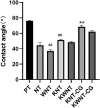Osseointegration Effect of Micro-Nano Implants Loaded With Kaempferol in Osteoporotic Rats
- PMID: 35284417
- PMCID: PMC8905647
- DOI: 10.3389/fbioe.2022.842014
Osseointegration Effect of Micro-Nano Implants Loaded With Kaempferol in Osteoporotic Rats
Abstract
Objective: To investigate the effect of osseointegration of kaempferol loaded on the surface of micro-nanomorphic implants in ovariectomized rats. Methods: Titanium flakes were polished to obtain the PT group, anodized and acid-etched to obtain the NT and WNT groups, loaded with kaempferol to obtain the KNT and KWNT groups, and spin-coated on chitosan-gelatin composite film to obtain the KNT-CG and KWNT-CG groups. In vitro experiments were performed to observe the physicochemical properties of the titanium tablets in each group through scanning electron microscopy and contact angle experiments. The cytotoxicity and drug release pattern were observed using CCK-8 and drug release assays. An osteoporosis rat model was established. Pure titanium implants were divided into PT, NT, WNT, KNT-CG, and KWNT-CG groups after the same treatment and used in the in vivo experiments and then implanted in the femur of mice in each group. After 4 weeks, all samples were collected for toluidine blue staining, micro-computed tomography scanning, and bone morphometry analysis to evaluate their osteogenic properties. Results: According to scanning electron microscopy, the surface of the titanium flakes had a micro-nano morphology in the WNT group and the KNT and KWNT groups were functionally loaded with kaempferol. In CCK-8 and drug release experiments, the loaded kaempferol and gelatin composite membranes showed no significant toxic effects on cells. The drug release time in the KNT-CG and KWNT-CG groups was significantly longer than that in the KNT and KWNT groups, with the release time in the KWNT-CG group reaching 15 days. In vivo experiments micro-computed tomography and bone morphometry analysis showed that the osteoporosis model had been successfully constructed. The bone volume fraction around the implant increased. Toluidine blue staining showed new bone formation and a significantly increased number of bone trabeculae. Conclusion: Kaempferol micro-nanocomposite coating improved the osseointegration ability of implants in osteoporotic rats.
Keywords: Kaempferol; Osseointegration; Osteoporosis; chitosan; gelatin; implants; micro-nano.
Copyright © 2022 Wang, Yuan, Song, Zang and Yu.
Conflict of interest statement
The authors declare that the research was conducted in the absence of any commercial or financial relationships that could be construed as a potential conflict of interest.
Figures










Similar articles
-
Osseointegration of layer-by-layer polyelectrolyte multilayers loaded with IGF1 and coated on titanium implant under osteoporotic condition.Int J Nanomedicine. 2017 Oct 19;12:7709-7720. doi: 10.2147/IJN.S148001. eCollection 2017. Int J Nanomedicine. 2017. Retraction in: Int J Nanomedicine. 2021 Oct 26;16:7231-7232. doi: 10.2147/IJN.S345534. PMID: 29089765 Free PMC article. Retracted.
-
Effects of micro/nano strontium-loaded surface implants on osseointegration in ovariectomized sheep.Clin Implant Dent Relat Res. 2019 Apr;21(2):377-385. doi: 10.1111/cid.12719. Epub 2019 Feb 4. Clin Implant Dent Relat Res. 2019. PMID: 30715786
-
Kaempferol-immobilized titanium dioxide promotes formation of new bone: effects of loading methods on bone marrow stromal cell differentiation in vivo and in vitro.Int J Nanomedicine. 2018 Mar 19;13:1665-1676. doi: 10.2147/IJN.S150786. eCollection 2018. Int J Nanomedicine. 2018. PMID: 29593412 Free PMC article.
-
Coating Polyelectrolyte Multilayers Loaded with Quercetin on Titanium Surfaces by Layer-By-Layer Assembly Technique to Improve Surface Osteogenesis Under Osteoporotic Condition.J Biomed Nanotechnol. 2021 Jul 1;17(7):1392-1403. doi: 10.1166/jbn.2021.3115. J Biomed Nanotechnol. 2021. PMID: 34446142
-
Improved osseointegration of 3D printed Ti-6Al-4V implant with a hierarchical micro/nano surface topography: An in vitro and in vivo study.Mater Sci Eng C Mater Biol Appl. 2021 Jan;118:111505. doi: 10.1016/j.msec.2020.111505. Epub 2020 Sep 11. Mater Sci Eng C Mater Biol Appl. 2021. PMID: 33255064
Cited by
-
Molecular mechanism of Achyranthis bidentatae radix and Morindae officinalis radix in osteoporosis therapy: An investigation based on network pharmacology, molecular docking, and molecular dynamics simulations.Biochem Biophys Rep. 2023 Nov 24;36:101586. doi: 10.1016/j.bbrep.2023.101586. eCollection 2023 Dec. Biochem Biophys Rep. 2023. PMID: 38076660 Free PMC article.
-
Strontium-doping promotes bone bonding of titanium implants in osteoporotic microenvironment.Front Bioeng Biotechnol. 2022 Sep 15;10:1011482. doi: 10.3389/fbioe.2022.1011482. eCollection 2022. Front Bioeng Biotechnol. 2022. PMID: 36185426 Free PMC article.
-
Enhancing bone regeneration using kaempferol as an osteoprotective compound: signaling mechanisms, delivery strategies, and potential applications.J Biol Eng. 2025 Aug 6;19(1):74. doi: 10.1186/s13036-025-00545-5. J Biol Eng. 2025. PMID: 40770779 Free PMC article. Review.
-
Nanotechnology in Osteogenesis and Inflammation Management: Metal-Organic Frameworks, Metal Complexes, and Biomaterials for Bone Restoration.Biomedicines. 2025 Jun 30;13(7):1597. doi: 10.3390/biomedicines13071597. Biomedicines. 2025. PMID: 40722669 Free PMC article. Review.
-
Kaempferol attenuates particle-induced osteogenic impairment by regulating ER stress via the IRE1α-XBP1s pathway.J Biol Chem. 2024 Jun;300(6):107394. doi: 10.1016/j.jbc.2024.107394. Epub 2024 May 18. J Biol Chem. 2024. PMID: 38768813 Free PMC article.
References
-
- Bastami F., Paknejad Z., Jafari M., Salehi M., Rezai Rad M., Khojasteh A. (2017). Fabrication of a Three-Dimensional β-tricalcium-phosphate/gelatin Containing Chitosan-Based Nanoparticles for Sustained Release of Bone Morphogenetic Protein-2: Implication for Bone Tissue Engineering. Mater. Sci. Eng. C 72, 481–491. 10.1016/j.msec.2016.10.084 - DOI - PubMed
-
- Elena F., Tomas S., Zbynek S., Monika S., Margit Z., Karel B., et al. (2014). Support for the Initial Attachment, Growth and Differentiation of MG-63 Cells: a Comparison between Nano-Size Hydroxyapatite and Micro-size Hydroxyapatite in Composites. Int. J. Nanomedicine 9, 3687–3706. 10.2147/IJN.S56661 - DOI - PMC - PubMed
-
- Gittens R. A., Mclachlan T., Olivares-Navarrete R., Ye C., Berner S., Tannenbaum R., et al. (2011). The Effects of Combined Micron-/submicron-Scale Surface Roughness and Nanoscale Features on Cell Proliferation and Differentiation. Biomaterials 32 (13), 3395–3403. 10.1016/j.biomaterials.2011.01.029 - DOI - PMC - PubMed
LinkOut - more resources
Full Text Sources
Research Materials

